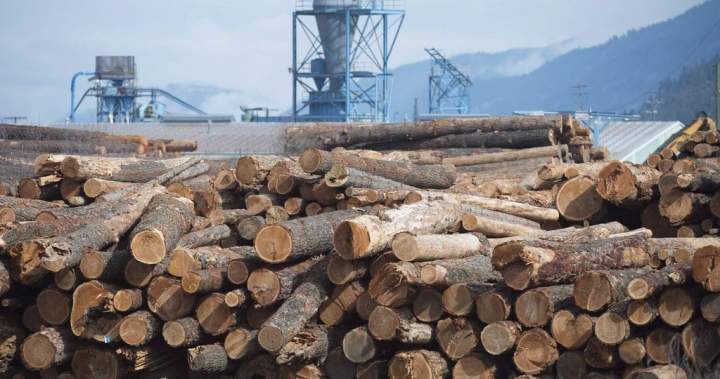The ongoing lumber dispute between Canada and the United States might finally see movement toward resolution, as former Bank of Canada governor Mark Carney suggested a potential framework centered around export quotas during a recent appearance before a parliamentary committee.
Carney, now serving as a key economic advisor to Prime Minister Justin Trudeau, outlined a potential compromise to the decades-long trade irritant that has cost Canadian producers billions in duties since 2017 alone.
“There’s potential for a quota-based system that would provide certainty for Canadian producers while addressing U.S. concerns about market share,” Carney told MPs at the House of Commons finance committee. “We need to be realistic about what’s achievable in the current economic and political climate.”
The timing is significant, as Canadian lumber producers have paid approximately $9 billion in countervailing and anti-dumping duties to the U.S. since the last agreement expired. These duties, currently averaging 8.05%, have created significant financial pressure on an industry that employs over 200,000 Canadians directly and indirectly.
Industry insiders suggest a quota system would be palatable if it allows for predictable market access. Susan Yurkovich, President of the BC Lumber Trade Council, told me in a phone interview that certainty trumps perfection at this point.
“After years of litigation and billions in duties, our members want stability. A reasonable quota that allows for growth would be preferable to the constant threat of changing duty rates,” Yurkovich explained.
The U.S. position has traditionally been that Canadian lumber is unfairly subsidized because most timber is harvested from Crown lands, unlike the private ownership model dominant in the U.S. This fundamental disagreement has complicated negotiations for decades.
However, economic realities might force both sides toward compromise. U.S. housing starts remain strong despite mortgage rate fluctuations, with the National Association of Home Builders estimating demand for approximately 38 billion board feet of lumber this year. American domestic production can only supply about 70% of this demand.
“U.S. homebuilders have consistently opposed duties because they increase construction costs,” notes Robert Dietz, chief economist at the National Association of Home Builders. “A steady, predictable supply of Canadian lumber benefits American consumers.”
Carney’s comments align with Treasury Board President Anita Anand’s recent statements that finding a resolution ranks among the government’s highest trade priorities. Sources familiar with the negotiations suggest informal talks have intensified following President Biden’s visit to Ottawa last spring.
Any new agreement would require careful navigation of the varying regional interests within Canada. British Columbia producers, who traditionally exported the highest volumes to the U.S., have diversified toward Asian markets after years of trade uncertainty and mountain pine beetle impacts. Meanwhile, producers in Quebec and Ontario remain heavily dependent on U.S. markets.
Janice Charette, Canada’s ambassador to Washington, has been leading technical discussions focused on potential quota mechanisms, including whether they would vary by region and how they might adjust during market fluctuations.
“We’re exploring frameworks that would provide stability while respecting the integrated nature of the North American forest products market,” Charette said during a recent Canada-U.S. business forum.
The economic stakes extend beyond the lumber industry itself. With housing affordability concerns mounting on both sides of the border, lumber prices significantly impact construction costs. The Random Lengths composite price index shows lumber currently trading around $450 per thousand board feet – down from pandemic peaks but still historically elevated.
Paul Quinn, forest products analyst at RBC Capital Markets, estimates that duties add approximately $40-60 per thousand board feet to Canadian lumber costs. “Eliminating or reducing these duties would immediately improve affordability in an already tight housing market,” Quinn explained.
Some industry observers remain skeptical about near-term resolution prospects. Derek Nighbor, President of the Forest Products Association of Canada, cautions that previous attempts at negotiation have faltered on similar concepts.
“We’ve been down this road before,” Nighbor told me. “The devil is always in the details – quota levels, regional allocations, surge protections, and duration all become sticking points.”
Political timing adds another layer of complexity. With a U.S. presidential election approaching and Canada possibly heading toward one as well, the window for meaningful negotiation may be narrowing.
Carney acknowledged these challenges but emphasized that economic pragmatism might create opportunity. “Both countries benefit from certainty and stability in this sector. The alternative – continued litigation and unpredictable duty rates – serves neither economy well.”
The history of Canada-U.S. lumber disputes stretches back to the 1980s, with periodic agreements providing temporary stability. The most recent Softwood Lumber Agreement expired in 2015, leading to the current round of duties imposed by the U.S. Department of Commerce.
Canadian companies have repeatedly won appeals at various trade tribunals, but the U.S. has maintained duties through new investigations and methodologies. This legal-commercial cycle has created what former trade negotiator Gordon Ritchie once called “a full employment program for trade lawyers.”
Carney’s quota proposal suggests the Trudeau government may be willing to accept certain trade-offs to end this cycle. While quota systems limit market access during strong demand periods, they could eliminate the costly duties and provide the predictability producers crave.
As negotiations continue behind closed doors, stakeholders on both sides recognize that perfect solutions remain elusive. After decades of dispute, the question may be whether a compromise agreement represents meaningful progress or simply another temporary truce in North America’s longest-running trade conflict.






